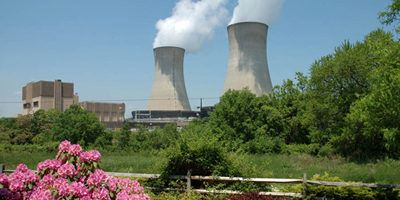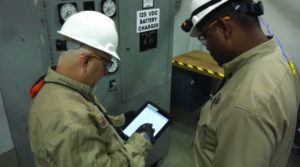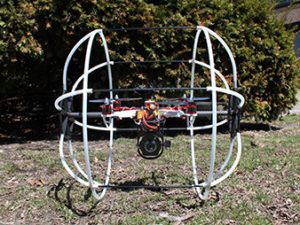Digitizing Exelon: Bringing Nixon-era Nuclear Power Plants Into The 21st Century

Exelon is one of the largest energy utilities in the world and operates more nuclear power plants than any other company in the US, but its electrical transmission equipment, natural gas and nuclear plants are aging rapidly. How can Exelon's extremely costly and complex, yet vital, infrastructure be brought successfully into the digital age?
Exelon is one of the world’s largest energy companies, with operations across much of North America[i]; it is the third largest utility company in the US by number of customers[ii]. About 55% of Exelon’s power generation facilities are nuclear power plants, rendering it the largest operator of nuclear energy facilities in the United States[iii]. The sheer volume of complex and expensive infrastructure owned and operated by Exelon would seem to make digitization of such an entity a daunting challenge. This is especially true as much of the infrastructure is aging- for example, the oldest nuclear plant operated by Exelon was licensed in 1969[iv]. And yet, Exelon has become a leader in bringing its business into the digital age. How have they done this?
Exelon has established a team whose mandate is to explore new ways of applying emerging digitization technologies to their business[v] and is actively exploring a number of major focus areas. We can explore several of these in turn.
Enabling Workers Through Digitization
Exelon has embarked on plans to digitize operations within its nuclear plants in the hopes of boosting their operating efficiency. They have replaced paper operating procedures with “Electronic Work Packages”[vi], or eWPs, enabling rapid dissemination and updates of critical instructions, and correction of errors in work documentation. Workers can use any computer or tablet at any Exelon location to get the eWPs, and can also send imagery and video back to engineers using the same devices[vii].

Digitization at Exelon has not been limited to its reactors; at the company’s natural gas plants, it created a suite of mobile apps and distributed tablets to its workers in the plants to send and receive data in a similar fashion to the eWPs [viii]. They have also developed their IT security to a point where workers can bring in any internet-enabled device- mobile, tablet or otherwise- and securely access the Exelon network and apps within Exelon facilities[ix], a capability they refer to as “bring-your-own-device (BYOD)”[x].
Analytics/ Internet of Things (IoT)
Exelon has also applied data analytics to the challenge of making its nuclear plants operate more efficiently. It has started test programs in five nuclear facilities for using “big data” in an attempt at predictive maintenance- taking components offline for maintenance or replacement before they actually fail in service[xi]. Partnering with GE to analyze the data, they have managed to use this initiative to reduce unnecessary losses in power generation capacity by 10%[xii]. Exelon has also announced plans to invest $25 billion in “smart grid” technologies[xiii], which use internet-enabled, two-way communication power meters to detect faults and efficiently allocate power across its network[xiv].
Robotics


A subsidiary of Exelon, Commonwealth Edison, has been licensed by the FAA to use drones to check for damage to electrical transmission equipment after storms; Exelon is also studying the use of drones in a security role to patrol the perimeters of its nuclear plants [xv]. The company has used robots in a test role at its LaSalle nuclear plant to clean highly radioactive parts of the facility and reduce required worker exposure to radiological hazards[xvi].
Future
What more could Exelon do in this space? Exelon has discussed a focus on additive manufacturing but appears to have taken minimal steps in this direction to date; I think a program of 3-D printing in-house replacement parts, in metal[xvii], would help dramatically to reduce further required maintenance lead times and feed into their attempt to better conduct predictive maintenance.
Their robotics program is promising but has only been used experimentally; I would scale this program up more rapidly and perhaps integrate it with their BYOD/app ecosystem, so that workers could, for example, use their phones or even smartwatches to control robots in the process of inspecting or maintaining their plants.
Another future area of technology that would be fruitful for Exelon to explore is the use of virtual reality/augmented reality (VR/AR) for training workers in maintenance or operating robots actually performing that maintenance. Use of devices like the Oculus Rift[xviii] or Microsoft HoloLens[xix] could enable Exelon workers to, for example, allow workers to perform maintenance tasks while seeing the instruction manual, schematics, or videos of the work being done overlaid on the actual parts being worked on[xx].

Exelon has set an example for the industry of how to efficiently digitize an operation that relies in large part on equipment designed and built in an era when mainframes represented the state of the art. Exelon has recognized the enormous benefits to its business model of going digital; expect to see it continue to invest heavily in digitization of its operations going forward.
(Word count: 800)
Header image credit: NRC. Retrieved from < http://powernewswire.com/stories/510703471-limerick-nuclear-plant-s-unit-1-offline-for-scheduled-refueling-outage>
[i] “About Exelon: America’s Leading Energy Provider”. Exelon. <http://www.exeloncorp.com/company/about-exelon> Retrieved 13 November 2016.
[ii] Warmoth, Brian. “The 10 biggest U.S. electric utilities visualized”. Utility Dive. 22 August 2012. <http://www.utilitydive.com/news/10-biggest-utilities-us/49322/> Retrieved 14 November 2016.
[iii] “The top 10 biggest power companies of 2014”. power-technology. 2 October 2014. <http://www.power-technology.com/features/featurethe-top-10-biggest-power-companies-of-2014-4385942/> Retrieved 14 November 2016.
[iv] “R.E. Ginna Nuclear Power Plant”. Nuclear Regulatory Commission. <http://www.nrc.gov/info-finder/reactors/ginn.html> Retrieved 13 November 2016.
[v] “Exelon CIIO Creates Structure, Culture For Innovation”. Deloitte CIO Journal. 31 March 2016. <http://deloitte.wsj.com/cio/2015/03/31/exelon-ciio-creates-structure-culture-for-tech-led-innovation/> Retrieved 13 November 2016.
[vi] “Exelon Employees Win Top Nuclear Industry Innovation Award”. Nuclear Energy Institute. 14 May 2015. <http://www.nei.org/News-Media/Media-Room/News-Releases/Exelon-Employees-Win-Top-Nuclear-Industry-Innovati> Retrieved 14 November 2016.
[vii] “Exelon Employees Win Top Nuclear Industry Innovation Award”. Nuclear Energy Institute. 14 May 2015. <http://www.nei.org/News-Media/Media-Room/News-Releases/Exelon-Employees-Win-Top-Nuclear-Industry-Innovati> Retrieved 14 November 2016.
[viii] “Exelon CIIO Creates Structure, Culture For Innovation”. Deloitte CIO Journal. 31 March 2016. <http://deloitte.wsj.com/cio/2015/03/31/exelon-ciio-creates-structure-culture-for-tech-led-innovation/> Retrieved 13 November 2016.
[ix] “Exelon CIIO Creates Structure, Culture For Innovation”. Deloitte CIO Journal. 31 March 2016. <http://deloitte.wsj.com/cio/2015/03/31/exelon-ciio-creates-structure-culture-for-tech-led-innovation/> Retrieved 13 November 2016.
[x] “Exelon CIIO On Leading Both IT and Innovation”. Deloitte CIO Journal. 30 March 2016. <http://deloitte.wsj.com/cio/2015/03/30/exelon-ciio-on-leading-both-it-and-innovation/> Retrieved 13 November 2016.
[xi] Reitenbach, Gail. “Big Data and Industrial Internet Meet the Power Plant”. Power. 1 January 2016. <http://www.powermag.com/big-data-industrial-internet-meet-power-plant/?pagenum=6> Retrieved 14 November 2016.
[xii] Reitenbach, Gail. “Big Data and Industrial Internet Meet the Power Plant”. Power. 1 January 2016. <http://www.powermag.com/big-data-industrial-internet-meet-power-plant/?pagenum=6> Retrieved 14 November 2016.
[xiii] “Exelon Utilities budgets US$25bn for smart grid tech”. Metering and Smart Energy International. 17 June 2016. <https://www.metering.com/news/exelon-us25bn-smart-grid-investment/> Retrieved 14 November 2016.
[xiv] “Smart Grid”. DOE Office of Electricity Delivery & Electricity Reliability. <http://energy.gov/oe/services/technology-development/smart-grid> Retrieved 14 November 2016.
[xv] Sobczak, Blake. “Drone rules pose risks and rewards for nuclear power plants”. E&E Publishing EnergyWire. 30 April 2015. <http://www.eenews.net/stories/1060017725> Retrieved 13 November 2016.
[xvi] Cato, Daren, and Joan Knight. “Use of Robotics for Dose Reduction and Efficiency Gains at US Commercial Nuclear Facilities”. Duke Energy, Exelon, National Institute of Standards and Technology. 25 August 2016. <https://www.nist.gov/sites/default/files/documents/2016/08/25/Session3_Presentation6_Cato_Knight_Use-of-Robotics-for-Dose-Reduction-and-Efficiency-Gains-at-US-Commercial-Nuclear-Facilities.pdf> Retrieved 13 November 2016.
[xvii] Mann, Ted. “3-D Printing Expands to Metals, Showing Industrial Promise”. The Wall Street Journal. 11 November 2016. <http://www.wsj.com/articles/3-d-printing-expands-to-metals-showing-industrial-promise-1478860204> Retrieved 14 November 2016.
[xviii] Stein, Scott, and Sean Hollister. “Oculus Rift: Welcome to the Future”. CNET. <https://www.cnet.com/special-reports/oculus-rift-review/> Retrieved 14 November 2016.
[xix] McBride, Sarah. 23 May 2016. “With HoloLens, Microsoft Aims to Avoid Google’s Mistakes”. Reuters. <http://www.reuters.com/article/us-microsoft-hololens-idUSKCN0YE1LZ> Retrieved 14 November 2016.
[xx] Gitlin, Jonathan. “Hyundai’s augmented reality manual: A simple but extremely good idea”. Ars Technica. 10 January 2016. <http://arstechnica.com/cars/2016/01/hyundais-augmented-reality-manual-a-simple-but-extremely-good-idea/> Retrieved 14 November 2016.



This was a very thoughtful post. I am impressed by how many types of technology you touched upon in such a concise manner — kudos!
I am curious about your thoughts on ranking the technologies you mentioned in terms of ease of implementation and ROI? I ask because given the myriad options available to Excelon and constraints on capital and IT personnel, I would imagine Excelon will need to prioritize its digitization efforts. I like the idea of drone inspections for transmission, but I worry that the regulatory approval and subsequent rate setting process for investing in this technology will slow its adaptation. To me, it seems that technologies that have clear value propositions for merchant generation assets will be the easiest to adopt. Of the technologies you mention, the eWPs and their boost to employee productivity seem like some of the lowest hanging fruit. What do you think?
I enjoyed reading your post, Captain Koloth, and it is an interesting extension of the climate change conversations in our last TOM challenge. I would like to open up two questions around operating and capital funding that I think are important as we think about putting digitization upgrades into practice.
1) BYODevice is an increasingly popular method of operation among many businesses (e.g. consulting firms, oilfield services, Fortune 500), but questions often arise around the cost. Employees do not want to use personal funds to pay for the device or monthly data plans from personal expenditure if it is required for their job. Employers, on the other hand, sometimes want to use BYOD as a way to offset their operating costs. How is Exelon addressing this challenge and are there learnings that can be applied to other power companies or industries?
2) The capital investment required to go digital can be very significant. How does Exelon think about the long-term vs short-term tradeoffs of investing in digitization for 40+ year old facilities? While I applaud Exelon’s efforts to stay ahead of the technology curve, I wonder if it is a good use of investor funds to invest (for example) $100 on old technology that will have to be replaced in 10 years vs investing $200 in new technology with a 30 year useful life. This is a question I’m sure we can also find in other industries so perhaps key learnings could be applied to Exelon as well.
Thanks for the post! I am a big fan of the nuclear industry and thought many of the digital solutions have great potential. Using virtual reality could have enormous impacts in the effectiveness of training and radiologically sensitive maintenance. With regard to training, virtual reality could provide workers with a view of power plant components which are inaccessible due to radiation concerns or space constraints. During my last tour, I spent a considerable amount of time in a shipyard doing high level maintenance. As a result, I gained a much greater understanding of the reactor plant and engine room than I would have otherwise simply by seeing equipment overhauled. Additionally, virtual reality could provide a fast, low cost solution for workers to learn worksites and rehearse maintenance in radiologically sensitive areas. There are strict regulations regarding people’s exposure to radiation. As a result, anything which reduces the amount of time a worker must be in areas of higher radiation helps increase safety, improve worker utilization, and reduce costs.